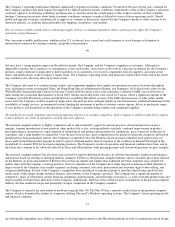Apple 2003 Annual Report Download - page 30
Download and view the complete annual report
Please find page 30 of the 2003 Apple annual report below. You can navigate through the pages in the report by either clicking on the pages listed below, or by using the keyword search tool below to find specific information within the annual report.
average interest rate earned by the Company on its cash, cash equivalents and short-term investments fell to 1.89% in 2003 compared to 2.85%
in 2002. The decrease is offset by the increase of $14 million from the gain on the sales of short term investments from the Company's fixed
income portfolio, and the increase of $6 million from the gain on the forward purchase agreement during the fourth quarter of 2003.
Net interest and other income was $112 million in fiscal 2002, compared to $217 million in fiscal 2001. This $105 million or 48% decrease
was primarily the result of declining investment yields on the Company's cash and short-term investments resulting from substantially lower
market interest rates. The weighted average interest rate earned by the Company on its cash, cash equivalents and short-
term investments fell to
2.85% in 2002 compared to 5.38% in 2001.
Provision for Income Taxes
The Company's effective tax rate for 2003 was 26% compared to the higher statutory rate due primarily to research and development credits, a
non-taxable gain on stock repurchase and certain undistributed foreign earnings for which no U.S. taxes were provided. As of September 27,
2003, the Company had deferred tax assets arising from deductible temporary differences, tax losses, and tax credits of $452 million before
being offset against certain deferred tax liabilities and a valuation allowance for presentation on the Company's consolidated balance sheet. As
of September 27, 2003, a valuation allowance of $30 million was
35
recorded against the deferred tax asset for the benefits of tax losses that may not be realized. The valuation allowance relates principally to the
operating loss carryforwards acquired from NeXT and other acquisitions, the utilization of which is subject to certain limitations imposed by
the Internal Revenue Code. Management believes it is more likely than not that forecasted income, including income that may be generated as a
result of certain tax planning strategies, will be sufficient to fully recover the remaining net deferred tax assets. The Company will continue to
evaluate the realizability of the deferred tax assets quarterly by assessing the need for and amount of the valuation allowance.
On April 10, 2003, the Internal Revenue Service (IRS) proposed adjustments to the Company's federal income tax returns for the years 1998
through 2000, and the Company has made certain prepayments thereon. Certain of these adjustments are being contested through the IRS
Appeals Office. Substantially all IRS audit issues for years prior to 1998 have been resolved. Management believes that adequate provision has
been made for any adjustments that may result from tax examinations. However, the outcome of tax audits cannot be predicted with certainty.
Should any issues addressed in the Company's tax audits be resolved in a manner not consistent with management's expectations, the Company
could be required to adjust its provision for income tax in the period such resolution occurs.
Cumulative Effects of Accounting Changes
Financial Instruments with Characteristics of Both Liabilities and Equity
On May 15, 2003, the Financial Accounting Standards Board (FASB) issued SFAS No. 150, Accounting for Certain Financial Instruments
with Characteristics of Both Liabilities and Equity . SFAS No. 150 requires issuers to classify as liabilities certain freestanding financial
instruments that embody obligations for the issuer and have characteristics of both liabilities and equity. The Company adopted the provisions
of SFAS No. 150 on June 29, 2003, which resulted in a favorable cumulative effect type adjustment of approximately $3 million. This
adjustment represented the mark-to-market adjustment to fair value for a forward purchase agreement that allowed the Company to acquire
1.5 million shares of its common stock at a price of $16.64 per share. The Company settled this forward purchase agreement in August 2003.
The settlement resulted in an additional gain of approximately $6 million, which is included in interest and other income, net.
Accounting for Asset Retirement Obligations
On September 29, 2002, the Company adopted SFAS No. 143, Accounting for Asset Retirement Obligations , which addresses financial
accounting and reporting for obligations associated with the retirement of tangible long-lived assets and the associated asset retirement costs.
Net of the related income tax effect of approximately $1 million, adoption of SFAS No. 143 resulted in an unfavorable cumulative
-effect type
adjustment to net income during 2003 of approximately $2 million. This adjustment represents cumulative depreciation and accretion that
would have been recognized through the date of adoption of SFAS No. 143 had the statement been applied to the Company's existing asset
retirement obligations at the time they were initially incurred.
Accounting for Derivatives
The adoption of SFAS 133 during 2001 resulted in a favorable cumulative-
effect type adjustment of approximately $12 million, net of a related
income tax effect of approximately $5 million.
Further information related to the adoption of SFAS Nos. 133, 143 and 150 and the resulting cumulative accounting effects may be found in
Part II, Item 8 of this Form 10
-
K at Note 1 of Notes to Consolidated Financial Statements.
























